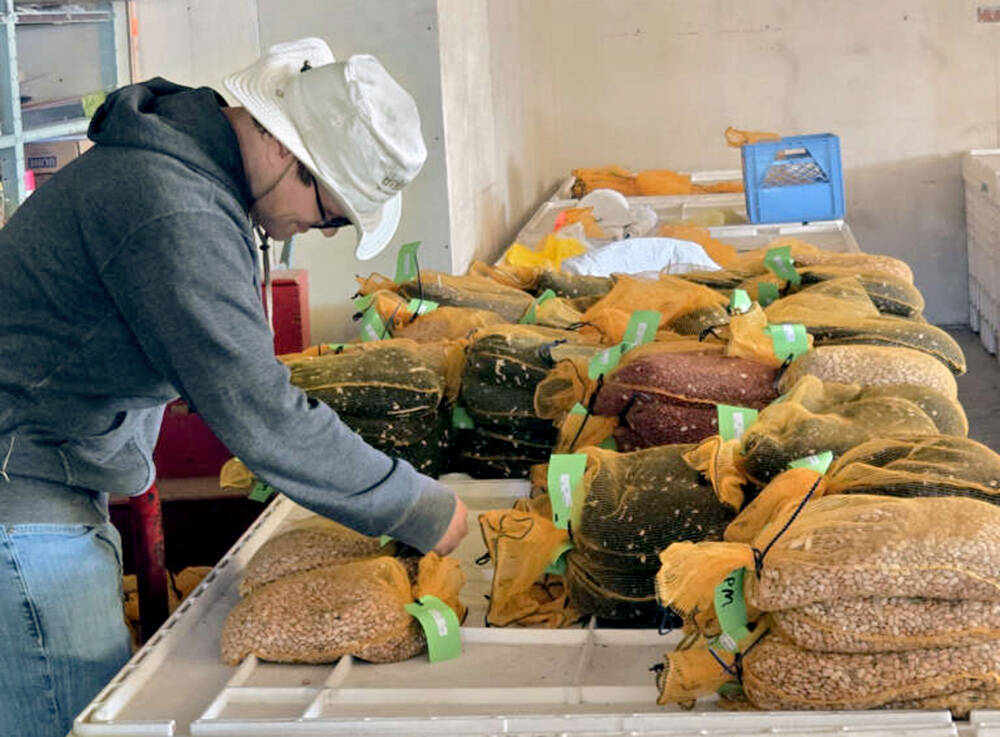Over the past month, above-average precipitation and normal temperatures have resulted in optimal growing conditions for Ontario and a large portion of the U.S. Midwest. The two-week forecast for the U.S. Corn Belt calls for above-average temperatures and normal precipitation.
This hot forecast comes as the U.S. corn crop is pollinating and the soybean crop is in the critical pod-setting phase. The markets may incorporate a risk premium due to uncertainty in U.S. corn and soybean production.
Quick look
Soybeans: Soybeans are priced higher at export terminals than for domestic use (Markets at a glance).
Corn: Ontario corn production is expected to be about 10 million tonnes.
Wheat: Hold milling-quality wheat for better prices later in the crop year.
Read Also

Bean research breeds community giving
University of Guelph dry bean researcher Dr. Mohsen Yoosefzadeh Najafabadi champions sustainability by donating surplus breeding program beans to support food security and community art initiatives.
Soybeans
At the time of writing this article in late July, soybean bids from domestic crushers were lower than prices from export terminals. During the summer, crushers take downtime for maintenance and upgrades, resulting in lower domestic demand.
Old-crop on-farm soybean stocks are expected to drop near historical lows. Old-crop export demand is also quiet as Ontario offers are premium to other origins. The Ontario soybean market is functioning to new crop positions as the upcoming crop develops under favourable conditions.
We continue to forecast an Ontario soybean crop of 4.2 million tonnes, up from last year’s output of four million tonnes and up from the five-year average of 3.9 million tonnes. Traders are expecting Ontario farmers to sell 3.2 million tonnes of soybeans from Sept. 1 through Dec. 31.
Brazilian soybeans were offered at US$424/tonne f.o.b. Paranagua for August loading, while U.S. soybeans were quoted at $436/tonne f.o.b. the Gulf. For September and October, this competitive situation reverses as U.S. soybeans are $13 to $15/tonne lower than Brazilian origin.
Basis levels in South America are strengthening as the exportable surplus declines. At the same time, the U.S and Ontario soybeans become the lowest-priced offers as new crop supplies become available.
U.S. farmers are expected to harvest 120.7 million tonnes of soybeans this fall, according to the USDA. This compares to the 2023 output of 113.4 million tonnes and forward for new crop U.S. soybeans but sales continue to lag sharply behind previous years.
The U.S. soybean carryout is tonnes, up from the 2023/24 ending stocks of 9.4 million tonnes and output of 12.1 million tonnes.
In the short term, the weather forecast for the Midwest calls for adverse heat during the key pod-set- ting phase. As of July 16, the managed money was net short with an estimated 183,145 contracts of soybeans on the Chicago futures market. This is a record short.
Therefore, we may see traders lower their yield projections, which would cause a short-covering rally. These rallies could extend beyond $1/bu. from current levels. This managed money buying comes when importers will step forward for new-crop U.S. and Ontario soybeans.
We’ve advised producers to be 100 per cent sold on old-crop soybeans and 20 per cent sold on expected new-crop production.
Corn
Ontario corn prices for old crop since early June. Ontario farmers are expected to hold minimal stocks at the end of the crop year and the domestic market is premium to world values. Ethanol margins have been favourable. Cattle-on-feed numbers in Ontario are above year-ago levels, enhancing domestic feed demand.
Ontario crops are developing under favourable conditions and we continue to project a crop size around 10 million tonnes. This is up from the 2023 production of 9.6 million tonnes and up from the five year average of 9.2 million tonnes. Ontario farmers are expected to sell 6.5 million tonnes of corn from Sept. 1 through Dec. 31. Basis levels will come under pressure at harvest as the market functions to encourage export demand.
European corn production is tonnes, up from the 2023 crop of 62.7 million tonnes. France’s crop is estimated at 12.9 million tonnes, compared to 12.7 million tonnes last year.
Ontario corn tends to trade into northern European countries, competing with EU domestic corn and feed wheat. European wheat production is estimated at 122 million tonnes, down from 126 million tonnes last year. However, adverse rain has downgraded a large portion of the French crop and to a lesser extent the German wheat crop.
Approximately 45-46 million tonnes of European wheat production trades into domestic feed channels every year, but for 2024/25, we could see up to 52 million tonnes move into feed markets. This will weigh on the European feed grain complex.
Usually, about 200,000 tonnes of U.S. corn trade into Ontario. That will be shut down this year due to the larger Ontario crop. We may see some Ontario corn trade into Mexico but the main homes will continue to be Ireland, Spain and the U.K. The Ontario corn market will price accordingly to trade into these main European destinations.
The funds will be large buyers of corn over the next couple of weeks and we’re also expecting a surge of export demand. This is an opportunity for Ontario farmers to catch up to our recommendation to be 20 per cent sold on new crop. Farmers should be 100 per cent sold on old crop.
Wheat
The Ontario winter wheat harvest is about 25 per cent complete. Adverse rains have delayed harvest progress. We haven’t heard of significant downgrades but we’re expecting some sprouting. Farmers have done a good job of spraying but there will likely be a fusarium problem.
About 500,000 to 600,000 tonnes of wheat always move into feed channels. Producers usually sell the bulk of this wheat during harvest or shortly after harvest. Some of this wheat will likely trade into Quebec, similar to last year.
We forecast a wheat crop of 2.1 million tonnes, down from the 2023 production of 2.7 million tonnes. Depending on sprouting and disease problems, there could be a tighter supply of milling-quality wheat. We don’t want to sell months of the crop year.
The U.S. winter wheat harvest has basically wrapped up and yields were better than expected.
The Northern Hemisphere spring wheat production is uncertain. In Russia, there is expanding dryness and we expect lower the overall wheat output. We were expecting bumper spring wheat crops in North Dakota, Minnesota and Western Canada. However, July has been hot and dry, which has tempered yield prospects. Traders have lowered their production estimates in Canada and the U.S.
We are still expecting a Canadian non-durum spring wheat tonnes, down from earlier estimates of 27.4 million tonnes and up from last year’s output of 22.6 million tonnes.
Near the end of July, Russian winter wheat was offered at US$220-$225/tonne f.o.b. the Black Sea. U.S. hard red winter was quoted at $260/tonne f.o.b. the Gulf while U.S. soft red winter was believe the wheat market is in the process of making the 52-week low.
We’re advising farmers with feed-quality wheat to sell about 30 per cent of the crop during or shortly after harvest. There are not too many options for the feed quality so producers may as well start moving it. If you have milling quality, we advise storing this wheat. We will likely make our first sales recommendation in November.













